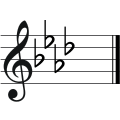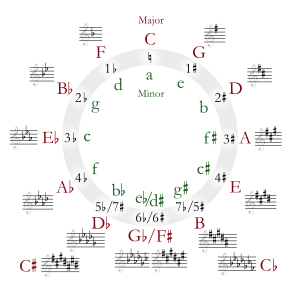F minor facts for kids
 |
||
| Relative key | A♭ major | |
|---|---|---|
| Parallel key | F major | |
| Notes in this scale | ||
| F, G, A♭, B♭, C, D♭, E♭, F | ||
F minor is a minor scale that starts on the musical note F. A musical scale is a set of notes played in a specific order. The F minor scale has a unique sound.
In music, a key signature tells you which notes are played higher or lower. The F minor key signature has four flats. When you play the F minor scale, the E♭ note is sometimes changed to an E♮. This creates a slightly different version of the scale called the harmonic minor.
Every minor key has a relative major key. For F minor, its relative major is A-flat major. It also has a parallel major key, which is F major. These keys share some notes or have the same starting note.
Many musicians and listeners connect F minor with strong feelings, like passion or sadness.
Contents
Famous Music in F Minor
Many famous composers have written beautiful pieces in F minor. These works often show the passionate or serious feeling of the key.
Here are some well-known pieces:
- Beethoven's Appassionata Sonata
- Haydn's Symphony No. 49 in F minor, La Passione
- Vivaldi's The Four Seasons (specifically the "Winter" concerto)
- Adele - Hello
- Máni Svavarsson - We Are Number One
- String Quartet No. 11, Op. 95 "Serioso" – Ludwig van Beethoven
- Violin Concerto L'inverno, RV 297, Op. 8, No. 4 – Antonio Vivaldi
- Piano Sonata No. 23, Op. 57 (Appassionata) – Ludwig van Beethoven
- Fantasia in F minor – Franz Schubert
- Fantaisie in F minor, Op. 49 – Frédéric Chopin
- Harpsichord Concerto No. 5, BWV 1056 – Johann Sebastian Bach
- Ballade No. 4, Op. 52 – Chopin
- Piano Quintet, Op. 34 – Johannes Brahms
- Piano Concerto No. 2, Op. 21 – Chopin
F Minor in History
During the Baroque period (roughly 1600-1750), composers often wrote music in F minor using a key signature with only three flats. Even today, some modern versions of this old music still show it written that way.
E-sharp Minor: A Different Name for the Same Sound
 |
||
| Relative key | G♯ major | |
|---|---|---|
| Parallel key | E-sharp major (enharmonic F major) | |
| Notes in this scale | ||
| E♯, F |
||
Sometimes, a musical key can have two different names but sound exactly the same. This is called being enharmonic. The E-sharp minor scale is an enharmonic equivalent of F minor. This means that if you play the notes of E-sharp minor, they will sound just like the notes of F minor. However, E-sharp minor has a much more complicated key signature with six sharps and one double sharp!
| Diatonic Scales and Keys | |||||||||||||||||||||||||||||||||||||||||||||||||||||||
|---|---|---|---|---|---|---|---|---|---|---|---|---|---|---|---|---|---|---|---|---|---|---|---|---|---|---|---|---|---|---|---|---|---|---|---|---|---|---|---|---|---|---|---|---|---|---|---|---|---|---|---|---|---|---|---|
|
|||||||||||||||||||||||||||||||||||||||||||||||||||||||
| The table shows the number of sharps or flats in each scale. Minor scales are written in lower case. | |||||||||||||||||||||||||||||||||||||||||||||||||||||||
See also
 In Spanish: Fa menor para niños
In Spanish: Fa menor para niños


